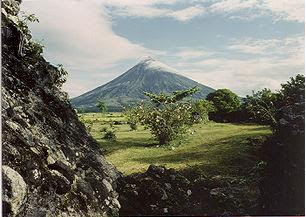The 1991 eruption of Mount Pinatubo is the world's second largest terrestrial eruption of the 20th century. Successful predictions of the onset of the climactic eruption led to the evacuation of tens of thousands of people from the surrounding areas, saving many lives, but as the surrounding areas were severely damaged by pyroclastic flows, ash deposits, and later, lahars caused by rainwater remobilising earlier volcanic deposits, thousands of houses were destroyed.
Fig: Map showing major volcanoes of the Philippines.
Fig: Map showing major volcanoes of the Philippines.
Mayon Volcano is the Philippines' most active volcano. The volcano has steep upper slopes that average 35–40 degrees and is capped by a small summit crater. The historical eruptions of this basaltic-andesitic volcano dates back to 1616 and ranges from Strombolian to basaltic Plinian eruptions.
Eruptions occur predominately from the central conduit and have also produced lava flows that travel far down the flanks. Pyroclastic flows and mudflows have commonly swept down many of the approximately 40 ravines that radiate from the summit and have often devastated populated lowland areas.
Fig: Mayon Volcano overlooks a pastoral scene approximately five months before the volcano's violent eruption in September 1984.
Taal Volcano has had 33 recorded eruptions since 1572. A devastating eruption occurred in 1911, which claimed more than a thousand lives. The deposits of that eruption consisted of a yellowish, fairly decomposed (non-juvenile) tephra with a high sulfur content. The most recent period of activity lasted from 1965 to 1977, and was characterized by the interaction of magma with the lake water, which produced violent phreatic explosions. Although the volcano has been dormant since 1977, it has shown signs of unrest since 1991, with strong seismic activity and ground fracturing events, as well as the formation of small mud geysers on parts of the island.
Kanlaon is the most active volcano in central Philippines and has erupted 25 times since 1866. Eruptions are typically phreatic explosions of small-to-moderate size that produce minor ashfalls near the volcano. On August 10, 1996, Kanlaon erupted without warning, killing British student Julian Green and Filipinos Noel Tragico and Neil Perez, who were among 24 mountainclimbers who were trapped near the summit.


No comments:
Post a Comment